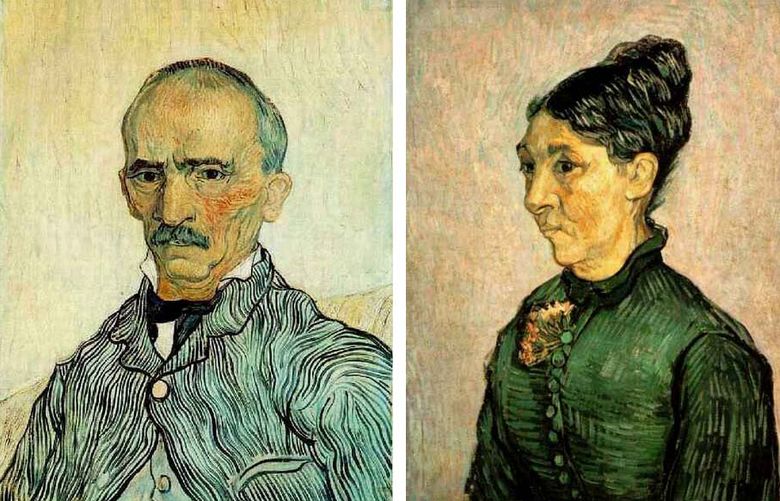
Vincent van Gogh wrote two portraits of the four Trabuk – a portrait of Charles-Elzear Trabuk and his wife Jehan Lafuey Trabuk. These paintings are remarkable both in terms of performance and in terms of their history. About the portrait of Mr. Trabuk, resident of the St. Paul Hospital, Van Gogh wrote this: Yesterday I started a portrait of the chief resident. Maybe I’ll write his wife, too, because he’s married and lives in a house a stone’s throw from the hospital. Very interesting person. Legros, if you remember, has a small engraving with the image of a Spanish nobleman, and so thanks to her you can get an idea of the type. This man went through a lot: he worked in the Marseilles Hospital during two epidemics of cholera. He saw an incredible amount of suffering and death, and his face expresses a kind of calm contemplation.
It is impossible to forget about Guizot’s face at the same time – there is something from him, but somewhat different. He is a man of the people, and not so convoluted. In any case, you will see this face if the portrait is successful, and I will make a copy. Saint-Rémy, 5 or 6 September 1889. Vincent liked the company of Mr. Trabuk. In fact, the biographer of the painter David Svitman suggests that “Trabuk, replacing the father and man close to the people, replaced the postman Ruhlen, who, in turn, replaced Tanga’s father.” But, despite Van Gogh’s sympathy for Mr. Trabuk, his wife, in a letter to Theo, Vincent responds with much less warmth – more likely even rudely: I finished the portrait of the resident, and made a copy for you. Surprisingly, the copy is noticeably different from the one I wrote at first, the look was unclear and clouded,
I gave the portrait to Major, and if his wife does not refuse to pose, I will write her. A faded and already unattractive woman is an unhappy, withdrawn and meaningless creature. It is so small that I would paint with a great desire a patch of dusty grass. Sometimes we talked when I wrote olives near their modest house and she said that she could not believe that I was sick – in fact, you would have said the same thing if you saw now how I work. The brain is so clear, and the hand is so hard that I made a copy of Delacroix’s “Pieta” without taking a single measure. Saint-Rémy, 7 or 8 September 1889. Both of the works were really wonderful, and Theo, in his own words, considered Mr. Trabuk’s portrait “extremely successful.” Ronald Pickwans, exploring the life and work of Van Gogh,
First, the figure was copied, then the background is shaded with a light addition of pink and turquoise. The figure is outlined with strokes. Referring to the portrait, Van Gogh did not mention the color. The palette is restrained and inexpressive, and seems subordinate to that deliberate linearity in the coat, face and neck, more free in the drawing of the background. The history of canvases is also interesting. First of all, none of the pictures is an original. Writing both portraits, Van Gogh gave their spouses Trabuk. And although the originals, unfortunately, were lost, Vincent once wrote for Theo copies from each of the portraits. They are exactly what they are today. The history of Mrs. Trabuk’s portrait is especially interesting in that the picture, which was considered “lost” for several decades, reappeared in the mid-nineties of this century. The picture was bought by Otto Krebs – until then it belonged to the Trannhauser Art Gallery, which in Berlin – and kept it in a safe in its own house in the vicinity of Weimar. So the canvas survived the Second World War.
Then it was inherited by the Krebs Foundation. Around 1947, a Russian officer entered the house of Krebs, who opened a safe and, finding a picture there, sent it to Leningrad. Until the 90s of the twentieth century, the Portrait of Madame Trabuk was kept in a special secret storage of the Hermitage. Obviously, even the director of the Hermitage at that time did not know about the existence of the repository and its contents. Biographical information. Charles-Elsear Trabuk was born on March 28, 1830 in the town of Manoscu, in Basset-Alpe. He died on September 25, 1896 in Saint-Rémy, six years after the death of Van Gogh. His wife, Jehan Lafui Trabuk, died in 1903.
 Portrait of Madame Trabuk by Vincent Van Gogh
Portrait of Madame Trabuk by Vincent Van Gogh Self-portrait with a palette by Vincent Van Gogh
Self-portrait with a palette by Vincent Van Gogh Portraits des quatre Trabuc – Vincent Van Gogh
Portraits des quatre Trabuc – Vincent Van Gogh Portrait of postman Joseph Ruhlen III by Vincent Van Gogh
Portrait of postman Joseph Ruhlen III by Vincent Van Gogh Self-portrait in a gray hat by Vincent Van Gogh
Self-portrait in a gray hat by Vincent Van Gogh Starry Night by Vincent Van Gogh
Starry Night by Vincent Van Gogh Walk of prisoners by Vincent Van Gogh
Walk of prisoners by Vincent Van Gogh Pieta by Vincent Van Gogh
Pieta by Vincent Van Gogh